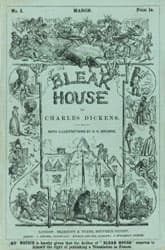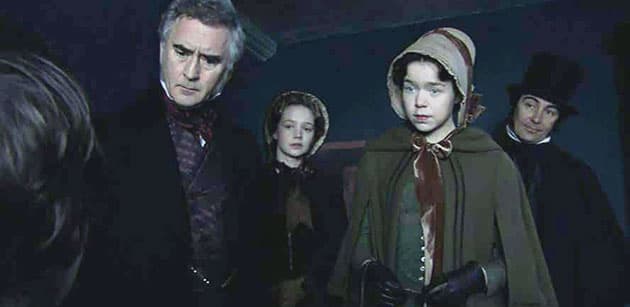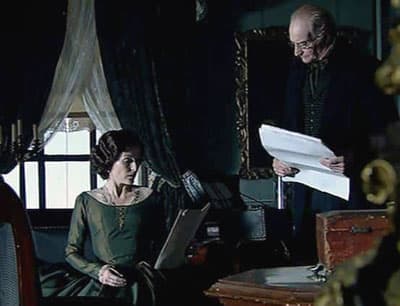Bleak House
Critique • Quotes • Text • At the movies
 First serial, 1852
First serial, 1852First publication
1852–1853 as twenty-part serial with illustrations by Phiz
Publication in book form
1853
Literature form
Novel
Genres
Literary, crime, mystery
Writing language
English
Author's country
England
Length
Approx. 166,000 words

Mr. Jarndyce, Ada, Esther and Mr. Skimpole hear Jo's tale of woe in 2005's Bleak House serial.
At the cold, bleak centre
Bleak House (2005): Television miniseries, eight hours; directors Justin Chadwick, Susanna White; writer Andrew Davies; featuring Gillian Anderson, Charles Dance, Timothy West, Denis Lawson, Anna Maxwell Martin, Carey Mulligan, Patrick Kennedy, Alun Armstrong, Phil Davis, Richard Harrington, Nathaniel Parker, Burn Gorman, Hugo Speer
The best example of how a modern filmmaker can condense, reform and otherwise adapt the Bleak House story—while maintaining the depth and emotional impact of the best aspects of the original novel—may be the 2005 serial created for the BBC.
It's BBC's third and longest adaptation of the novel. This condensation clocks in at about eight hours—initially presented in fifteen episodes. It's still a massive and detailed production. But the direction, staging and stellar acting keep viewers riveted to the human story over several days or weeks.
Heading the cast of mainly British theatrical and cinematic veterans is that great purveyor of villains, Charles Dance (perhaps best known for his roles as evil doers in Game of Thrones and the recent And Then There Were None). As scheming lawyer Tulkinghorn who roots out Lady Dedlock's scandalous past, he's so coldly effective that when the character is dispatched we are both pleased to see him get his just desserts and sorry to lose his malevolent presence for the rest of the story.
But at the still centre of Bleak House is the film's other revelation, Gillian Anderson. Since coming to world attention as Agent Scully on The X-Files in the 1990s, the British-American Anderson has carved out a career as a respected serious actor. As Lady Dedlock, she adopts a minimalist style displaying the icy demeanor that suits the character's Dickensian name, but moving the audience through stages of disdain, mystery and ultimately hard-won sympathy.
Anna Maxwell Martin as the lead character Esther Summerson, impoverished governess to the Jarndyces, and Dennis Lawson as her benevolent employer are both among the many actors who have been lauded for helping bring to life the personal stories behind the dry court case.
Trailer for BBC series of Charles Dickens's Bleak House in 2005.
The drama and relationships among them are handled very well with subtlety and nuance without bogging down in the legal and financial details that would otherwise threaten to overwhelm all sparks of humanity in the tale.
The sense of mystery—several mysteries actually—is kept up throughout this Bleak House, helped by the deep-toned, high-definition camera work, to keep viewers engaged and guessing throughout.
One hesitates to say such a story as Dickens's most painstakingly bleak novel could be entertaining, but in this adaptation it is. Both dark and enlightening.
— Eric
Critique • Quotes • Text • At the movies
1985, 2005


